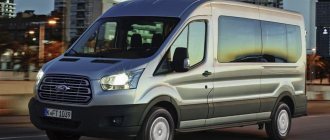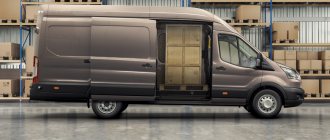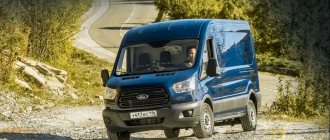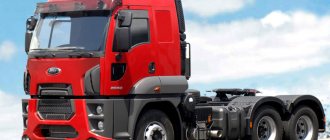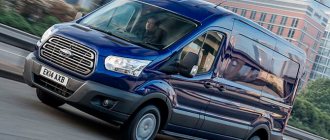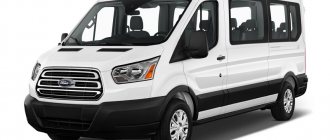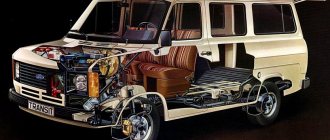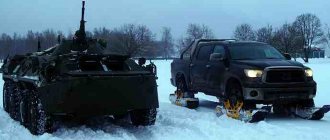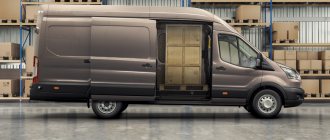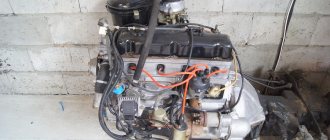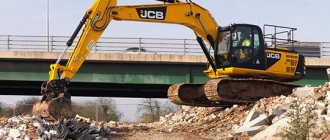Ford Transit is a group of cargo vans, flatbed cars, and minibuses that are manufactured in the West. For the last 40 years it has been a popular passenger car in Europe. The prevalence of Transit is evidenced by the fact that at the beginning of 2009 the company produced the six millionth copy of this category of cars. Let's discuss Ford Transit technical specifications.
Pictured is a Ford Transit cargo bus.
The eighth generation of Ford Transit features numerous auto assistants, Euro-4 engines, charging mechanisms and interesting innovations that make this car even more economical and reliable, setting it apart from its competitors.
Specifications
Dimensions of Ford Transit:
- length – 4.12 m;
- width – 2.25 m;
- height – 2.8 m.
Load capacity - 2.727 tons. The fuel tank holds up to 80 liters of fuel (a 103 liter tank is available). One tank refill will last up to 10 hours, since the average consumption of a car is relatively small (per hundred kilometers):
- in the city and highway – 8.4-8.9 l;
- in the city - 9.6-10.5 l;
- on the highway - 7.7-8 liters.
The maximum speed of the car is up to 120 km/h.
Motor
Ford Transit has a wide range of engines (powered by diesel fuel or gasoline). The main feature of the engines that are available for cars is profitability.
The photo shows a Ford Transit 2.2 tdci diesel engine
Innovative technologies make it possible to increase the efficiency of fuel consumption and reduce exhaust gases. For the passenger version, the five-cylinder 3.2 liter DuratorqTDCi engine is considered optimal. This is the last engine in this group. Torque is equivalent to 465 Nm, power – 195 hp. Such properties allow us to be the leader in power in this category.
The most popular in the category is a group of 2.2 liter Duratorq engines running on diesel fuel (sold in the Russian Federation). These engines are created taking into account the unique Euro-4 environmental safety assessment criteria. Power in the range of 105-150 hp.
They have an ECOPack environmental protection and fuel efficiency mechanism, which includes a speed limiter. Set to 100 km/h. If you want, you can turn off, so as not to worsen the technical properties, AutoStartStop (turns off the engine under certain circumstances or, on the contrary, instantly turns on the engine if necessary).
Among the additions in the eighth-generation Ford Transit engines, we highlight the modern function of monitoring battery charge, energy reuse and a sensor for whether it is necessary to change speed.
Common engine related difficulties:
- consumes excess oil;
- Unstable operation (car jerks).
Design
The latest generation of FordTransit in terms of design is not comparable to most similar cars. The car has an independent front suspension of the MacPherson type with springs with variable gas-filled shock absorbers and stiffness. A stabilizer bar is also needed. The rear suspension is designed as springs with shock absorbers. The car is successfully compatible even with difficult surfaces.
The car is equipped with a conventional reinforced brake mechanism and self-control of the pads.
A disc brake mechanism is mounted on 4 wheels.
FordTransit features a bold interior design that matches its exterior design. The car dashboard is multitasking and includes what you need. The driving experience is pleasant, similar to a traditional passenger car. With power steering, the driver does not use excessive force to move the steering wheel.
Safety
Ford Transit is considered one of the safest cars in this segment. The characteristics here will be provided by the following mechanisms:
- BTCS – traction and brake control;
- front airbags;
- ISOFIX fasteners installed on passenger seats;
- ESP – exchange rate stability mechanism;
- assistance mechanism for starting downhill;
- belts with three-point fixation.
Ford Transit in its main version has rear-wheel drive. This option has the following advantages:
- improved control of a loaded vehicle;
- Easier to move with a trailer.
The car is equipped with a modernized six-speed Durashift gearbox with increased performance. The lever moves without restrictions. No shaking is felt. FordTransit can withstand harsh conditions and low temperatures due to its increased generator output.
Maintenance and repair
It is necessary to carry out vehicle maintenance on time, otherwise the fuel, exhaust and other systems will soon begin to fail. Often, owners of this car have a problem with high fuel consumption. This is usually caused by a clogged filter. If you find smoke in the exhaust pipe, most likely the fastening is broken or the muffler structure is damaged.
Even if everything is fine with the machine, do not ignore scheduled maintenance and operating instructions. The service life of the vehicle greatly depends on this.
In what cases is it time to go to a car service center if:
- The starter is difficult to start. This creates a lot of noise. Often the problem is damaged gear teeth and starter bolts.
- If the engine starts, but immediately after that it stops working. This is caused by the presence of air in the fuel and the formation of paraffin. Sometimes the cause is a faulty starting heater.
- If attempts to start the engine do not yield results: it simply does not turn. There are many more reasons for such a breakdown and it is difficult to identify them without professional diagnostics.
You can order spare parts for Ford Transit from us - we provide high-quality components that match the characteristics of this car. Our service technicians will quickly diagnose and repair your car.
Minuses
Among the disadvantages:
- Weakened metal. Despite the high-quality coating, the metal of a car often corrodes after only 3-4 years of use.
- Mediocre noise immunity. In terms of these properties, FordTransit is not a leader, because the noise level in the car is high.
- Limited passages in passenger cars.
FordTransit is a modern car that combines the quality characteristics of convenience, economy and ecology and is wonderfully suitable for carrying out business work with the help of its excellent technical characteristics.
In the photo Ford Transit passenger 8 seats
Generations of cars Ford Transit is one of the oldest buses in the world. The first vehicle of this group appeared back in 1953 and was called FK1000. In 1961 the minibus was named Ford Taunus Transit. Selling abroad was not a dream then. But over time, car manufacturing has increased and the option has changed. The debut car with the name Ford Transit was announced in 1965. The van was produced in Turkey, Belgium, England, and then in China. The model was very different from ordinary cars in Europe. In 1978, the second family was released, which was then used not only for sales, but also in special services.
How to assemble a car
Let's take a closer look at where and how Ford Transit is assembled to make sure of their quality and reliability.
Assembly is carried out using modern technologies, which involve the use of high-tech robots. They perform all precise operations in critical areas. In particular, they are used to paint and weld roof panels. All this is done by an artificial hand:
- It rises sharply.
- It bends itself in the right areas.
- It goes through the doorway into the body.
- Gently touches the roof joint.
At the same time, on the other side, the listed operations are performed by another “limb”.
The quality of the work done is checked by a person with a jackhammer - an employee of the testing laboratory. A random body is removed from the conveyor and the surface is destroyed, creating mechanical stress along the weld points. One way is to hit it with a jackhammer. The essence of the test: the metal can tear anywhere, but the welding points must remain intact. Otherwise, the process is adjusted.
Build Quality Check
In addition to an employee with a jackhammer, the process is controlled by a laboratory using professional equipment and vehicle testing systems:
- laser-optical stand;
- vibration table;
- pressure chamber;
- test track with artificial obstacles.
The company's personnel checks the geometric parameters of the body, taking measurements at many points and comparing them with the optimal ones.
1978 Model "Mark2"
At the beginning of 1978, a tuning option appeared, known as the “Mark2”.
It has a redesigned nose, a modern interior and replaces the EssexV4 with a FordCortina Pinto engine. But in the first FordPinto engines, most vehicle owners encountered extraordinary wear on the camshaft, so for two years the Transit 75 was produced with a 1.6 liter FordKentXflo engine. Powerful Transit for special services used a variant of FordEssexV6engine engines.
In 1984, the York diesel engine was converted to 2.5 liter DI (direct injection). At the same time, the FordTransit was tuned, including a gray plastic grille at the front with built-in light fasteners, protection near the turn signals, extended bumper covers at the ends and rear lights for various purposes: reverse; turn, fog, more side lights for cargo options.
This small tuning is usually not counted as an updated “Mark” number.
Car history
The idea of creating this model came to the minds of the designers of the Ford automaker when they decided to strengthen their position in the European automobile market in the 60s.
The first cargo vans designed were called Redcap, but this was abandoned in favor of Transit, which was more understandable to most Europeans. Back then, in the 60s, Ford Transit cars looked spartan. They attracted buyers with their reliability and practicality.
Due to the ability of the platform to adapt to different modifications, Ford Transit has found application in various public spheres. It has been converted into police and fire trucks, medical carriages and school buses.
Growing demand in the cargo segment of the market gave impetus to the creation of three variants of Ford Transit models with different load capacities of 610 kg, 865 kg and 1120 kg.
Every few years, the external and internal appearance of the car was updated:
- 1971 - a new radiator grille, which gave the Ford Transit the appearance of a passenger car, a new 5.0-liter V-engine;
- 1972 - a diesel version of the engine appeared;
- 1975 – modernization of appearance (black radiator grille, bumpers, mirrors);
- 1978 - models with an extended body appeared, running on diesel and gasoline;
- 1984 - a 2.5 liter DI engine was installed on the cars;
- 1985 – new wide doors, independent suspension from McPherson;
- 1991 – installation of triple seats, 2.5-liter DI diesel engine with turbocharging, power increase to 100 hp. With.;
- 2000 - updated model in two versions - rear-wheel drive and front-wheel drive;
- 2002 - the new Ford Transit with a carrying capacity of 4.25 tons was introduced;
- 2006 – The gear shift lever was moved to the dashboard.
Over the course of numerous restylings, the Ford Transit has evolved from an ordinary practical car into one of the most recognizable and best-selling models on the market.
1986 model
In 1986, production of the fourth generation of the car began. It had a “single-box” body structure.
The creators moved away from the excessively protruding hood (the hood and front glass were now placed at the same angle). In 1992, the Ford Transit underwent extensive tuning. The bottom has been redesigned, and the distance between the axles has been made larger. The corrections also affected the construction of bridges, where cylindrical bearings began to be used. The third Ford Transit was distinguished by its confident maneuverability and speed, which attracted the attention of most customers. Single copies of this generation are still successfully used on our market.
Where is Ford Transit made in Russia?
In Russia, the production of the car lies at Ford Sollers in Yelabuga. The company is recognized as unique in the international automotive market: American management has become seriously interested in the Russian experience and plans to introduce it at factories in other countries.
Several versions of the car are produced on an ongoing basis in Yelabuga:
- all-metal van;
- cargo-passenger van;
- 14- and 17-seater Ford Transit minibuses;
- 6-, 8- and 9-seater combi.
There are many other special versions - the total number of models exceeds 55. They are used by ambulance services, police agencies, and transport companies involved in passenger and cargo transportation. All cars are manufactured in accordance with GOST requirements and Ford Motor Company quality standards.
Model Ford Transit IV
The sixth Ford Transit had a new appearance, borrowing styling characteristics from the Focus. The updated version was planned with both drive options (V184-185). There are also options with the Puma diesel engine installed in the Ford Mondeo and Jaguar XType.
For top variants they were given an automatic transmission. At the same time, the manufacturer takes care of the driver by adding many settings to the seat and steering wheel, making it possible to choose an ergonomic position. Thanks to the high seating position, wide visibility was obtained. The Ford Transit IV salon was larger and was planned to seat up to 12 people. Based on the regular model, the automaker has also prepared a smaller variation – Transit Connect. This option is slightly smaller than the “ancestor”, with an adjusted appearance added. Limit load capacity - 0.9 tons.
Ford Transit
Mark I Ford Transit
Mark I (United Kingdom Numbering) Ford Transit Minibus after facelift Ford Transit - ice cream van with a redesigned higher roof
The first real Ford Transit appeared in October 1965. At first the van was produced at the English plant. Langley, Berkshire in Berkshire, England (the former aircraft manufacturing plant that produced Hawker Hurricane fighters during World War II), but as demand outpaced the plant's capacity, production was moved to Southampton. Production of this generation was discontinued in 1978.
Transit came to replace the English one. The Ford Thames 400E is a small, mid-engine, front-wheel drive van known for its narrow track. Thames competed with similar-looking but larger English vans. Morris Commercial J4 Morris Commercial J2 and Commer PB series from Rootes Group. The UK market was then dominated by English. Bedford CA. Thames 400E was losing out to competition due to its limited loading area, which did not allow it to win a sufficient number of customers. So Ford went back to the drawing board and switched to a front-engine layout, following the course set in the 1950s by manufacturer Bedford with its well-regarded CA series vans. The revolutionary step of Henry Ford II was to combine the developments of English. Ford of Britain and English Ford of Germany to create a prototype for today's English. Ford of Europe - Previously, these subsidiaries avoided competition in each other's home markets, but were in direct competition in the rest of the European markets.
The Transit deviated from European commercial vehicles with its American design—the wide track gave a huge advantage in cargo capacity over comparable vehicles of the time. Most of the Transit's mechanical components were adapted from cars of the era. Another key to the success of the Transit is a large range of different body solutions [ source not specified 1503 days
]: long and short wheelbase cargo vans, flatbeds, minibuses, crew cabs are just some of the options available.
In the UK, an English engine was used for the petrol modification. Essex V4 with a volume of 1.7 liters. and 2.0 l. By favoring relatively short V4 engines, Ford was able to minimize the extra length required by the decision to place the engine in front of the driver.[3] Another popular improvement under the bonnet of a van was an alternator, while competitors in the UK market expected buyers to be satisfied with a DC alternator[3]. A diesel engine with an effective output of 43 hp was also offered. With. (32 kW), supplied by Perkins. Since this engine was too long to fit under the Transit's hood, the diesel version had a redesigned, longer engine bay. The low-power Perkins were not in demand and were replaced by Ford in 1974 with its own York engines. For mainland Europe, the Transit had the German Ford Taunus V4 engine in two versions: Cologne 1.7 liter. and Essex 2.0 l. The long nose of the diesel conversion was also used to accommodate the Ford 3.0L engine. V6 in police and ambulance vans, and in Australia to accommodate the inline 6-cylinder engine of the Ford Falcon.
According to the show Top Gear
; English police reported that in the 1970s, 95% of all robberies in which a car was used involved this type of Ford Transit.[1]
The choice of front and rear driving axles instead of a system that includes an independent front suspension, like the English one. The Ford Thames 400E may have been seen by some as a step back in time, but on the road commentators felt that the Transit's wider track and longer wheelbase more than compensated for the obvious step back represented by the suspension choices. Drivers also praised the elimination of excessive cabin heat that resulted from placing the driver above or directly next to the engine bay in the Thames 400E and other front-wheel drive light vans of the 1950s and early 1960s.[3]
2006 model
In 2006, such serious tuning took place that they decided to celebrate the car with an updated family. FordTransit acquired an updated interior, lights, and a modified front.
The gearbox has changed 100%. Diesel engines have acquired the HPCR mechanism, and gasoline engines have been taken over from the FordRanger. In 2007, Ford Transit was nominated for Van of the Year. Later the engines were updated again. After this, only engines that meet Euro 4 remained. This option remains the most famous among the Russians.
2013 model
In 2013, sales of FordTourneoCustom and TransitCustom started in the Russian Federation. The latter became the best in this category due to its high efficiency and safety indicators. These options are produced at the Yelabuga plant (RF).
Ford Transit is used to solve numerous problems. The flatbed option can be used for unloading or loading from the rear and side. The enlarged platform makes it possible to transport large scales without fear for the safety of the vehicle. An easily disassembled awning will provide protection from the influence of external elements. For logistics services, Ford Transit is ideal.
Passenger variations are often used in taxis, providing comfortable convenience and safe transportation conditions. Ford Transit is actually considered a special option, which is proven by the great demand for this car.
Cost of a used or ex-showroom Ford Transit
In our market, Ford Transit is presented only in versions with a 2.2 liter Duratorq engine of 136 or 125 hp. But 2.5 liter engines are also popular abroad. If the buyer wants, the car can be equipped with any type of drive.
In the minimum version, the car has an average distance between the wheels and relatively few instruments. The price for this option starts at RUB 1,906,000.
Additional promotional offers are given under the restyling program.
Options with an increased distance between the wheels will be more expensive - 1.905-2.337 million rubles. Options with an extended base (Jumbo) are top-end. Here prices start from 2.152 million rubles.
The market for used Ford Transit options in the Russian Federation is huge and unpredictable. The price of a used car can fluctuate significantly and is related to the condition, date of manufacture, kits and units. So, working versions of 2004-2005 are bought for 230-340 thousand rubles. Modern cars (2007-2009) will cost 400,000-650,000 rubles. Cars 2011-2013 will reach 0.5-0.9 million rubles.
Cost of ownership
The costs of operating a Ford Transit vehicle depend on the specific case. They are mainly influenced by the region with its specific conditions and the average annual mileage. There are other factors:
- Maintenance;
- insurance (CASCO and OSAGO);
- fuel costs - what are the prices for gasoline in the region and how much will you spend;
- transport tax on the car.
For example, for a driver in Yekaterinburg with an annual mileage of 15,000 km, the cost of owning a Ford Transit will be about 79,000 rubles per year.
